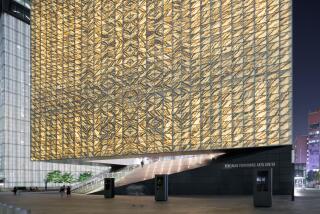Cincinnati hits a home run
Cincinnati
At 6th and Walnut streets, I became excited about Cincinnati again.
There it was, a building that in itself has the effect — the sense of newness, vitality and even beckoning mystery — that the entire city had for me as a youth. The building, designed by acclaimed London-based architect Zaha Hadid, is the Lois and Richard Rosenthal Contemporary Arts Center, which opened this summer.
Seeing it from a distance for the first time, while approaching it at one of the busiest intersections in this old Ohio River city’s downtown, is both soothing and invigorating. Its concrete rectangles float up and jut out from a first-floor glass base as if, like birds, they had decided to take flight.
The new building — the first by the Iraqi-born architect to be built in the U.S. — has the power to calm and center the visitor with its quiet palette and materials. At the same time, I was eager to see what might be inside the strange, inviting exterior.
Funny, that’s how I used to feel about coming to downtown from the suburbs at night when I was a teenager. It was an exciting journey into unknown territory, with the lights of the movie theater marquees, late-night orange-drink bars and chili parlors (a Cincinnati specialty) providing guidance. Much of that has been gone for years.
Cincinnati, like many cities, has struggled to keep its downtown alive. The low point came after the 2001 riots on downtown’s fringes. That resulted in a civic gloom and a decline in activities.
I had left long ago, first for Denver, then Los Angeles, and had stopped thinking of Cincinnati as an exciting destination years ago. Fortunately, civic leaders had not given up. Residents have long been proud of their attractive city, built as it is on verdant and gentle hills affording spectacular views of the Ohio River. And they never forgot what Charles Dickens wrote in his “American Notes”: “The inhabitants of Cincinnati are proud of their city as one of the most interesting in America and with good reason.” Or that Winston Churchill found it America’s most beautiful inland city. Or that Henry Wadsworth Longfellow called it the “Queen City of the West.”
So they set out to revive it. Years of effort suddenly are reaching critical mass. The $20.2-million contemporary art center — a worthy destination in itself — is but one of many new attractions, along with some vital old ones, that make a trip here a delight.
It’s an especially good place to visit in this year of Ohio’s bicentennial, when special events are being planned. The Tall Stacks Music, Arts & Heritage Festival, featuring visits from 17 riverboats, is Oct. 15-19. In a bid to make it a regional — even national — event, organizers this year have added outdoor concerts by 26 acclaimed roots acts, including Lucinda Williams, Emmylou Harris, Los Lobos, Bo Diddley, the Jayhawks, the Blind Boys of Alabama, Ricky Skaggs, Delbert McClinton and others. The cost to attend Tall Stacks and see all five days of concerts is $12. Riverboat cruise tickets cost more. (For information, call [866] 497-8255 or visit https://www.tallstacks.com.)
Capping the year, an exhibit of Vatican art treasures arrives on Dec. 20 at the Cincinnati Museum Center, in the spectacularly restored Art Deco-style Union Terminal train station, and runs through April 18.
An urban adventure
THE new Contemporary Arts Center building, the first free-standing home for the 64-year-old institution, is the most dramatic attraction in Cincinnati. The interior is every bit as exciting as the exterior. Although the 87,000-square-foot building is placed tightly into an 11,000-square-foot corner lot, it is surprisingly spacious. The building divides six floors of space into planes that seem to intersect with a logic apparent only as you experience it.Hadid’s innovative “urban carpet” design technique — the concrete floor curves up in a graceful swoop to become a rear wall — turns the arts center into a kind of playground. Near that wall are long, black walkways. I found myself running up and down them like a kid walking long, dark pirate-ship planks. Everyone I passed seemed to be having just as much fun.
On exhibit through Oct. 25 is a thought-provoking conceptual art show featuring work by 35 international artists, “Somewhere Better Than This Place: Alternative Social Experience in the Spaces of Contemporary Art.” It is a serious show with political aspects, but it also has a sense of fun. I was blown away — almost literally — by Monica Bonvincini’s “A Violent, Tropical, Cyclonic Piece of Art Having Wind Speeds of or in Excess of 75 Miles Per Hour,” which is just what it says it is. I’m glad I wasn’t wearing a hat.
Janet Cardiff’s “Forty-Part Motet” featured 40 speakers placed around an empty gallery with each playing a different voice singing English Renaissance court music. I wandered around it, sometimes with eyes closed, and listened as the voices came together and separated. I could have stayed forever.
Baseball on the river
A journey from the sublime to the raucous was easy once I left the museum. Several blocks south of the arts center is the new baseball park built along the Ohio River. The $280-million Great American Ball Park, which also opened this year and replaced an older stadium near the same site, isn’t as carefully “retro” as other new baseball stadiums and has been criticized. But I found it a cheery place that plays to the strengths of its riverfront locale. And because it’s essentially part of downtown, it gets walk-ups: About 6,000 people bought last-minute tickets the night I went. (The ballpark’s capacity is 42,256.)It has a terrace that overlooks both the Ohio River and one of its feeders, northern Kentucky’s Licking River. There’s also an outfield walkway where you can watch barges go by on one side and home runs fly into the seats on the other. And on the restricted-access suite level, pithy quotes from baseball heroes can be found on the walls, such as “I’d go through hell in a gasoline suit to play baseball,” by Pete Rose.
Cincinnati’s riverfront once was tough and gritty. But the riverfront gets most of its traffic now from users of the nearby new highways and buildings, not just the Great American Ball Park but also the new Paul Brown Stadium, for the Bengals, and the under-construction National Underground Railroad Freedom Center, a museum honoring the movement that helped slaves escape the South before and during the Civil War. It is scheduled to open next summer.
There’s also a 22-acre riverfront recreation area known as Bicentennial Commons at Sawyer Point Park, containing at its gateway Andrew Leicester’s controversial “flying pigs” sculpture, a whimsical tribute to Cincinnati’s 19th century heyday as a meat processing center known as Porkopolis.
On a rainy Sunday afternoon, I visited another new riverfront attraction, just past downtown in the East End. Called Theodore M. Berry International Friendship Park, it was conceived to honor the city’s first African American mayor (who died in 2000). The $8-million park opened in May. It’s a lovely, reflective example of an international trend: urban peace and friendship parks as a counterbalance to war memorials. It features some fine examples of landscape architecture and offers a place to get away from it all.
That same Sunday, I traveled up Mt. Adams — a steep hillside with picturesque, sometimes precariously situated homes — to Eden Park. There, the venerable Cincinnati Art Museum was opening its 18,000-square-foot Cincinnati Wing. (It spent $10 million renovating an existing building.) The museum says it is the nation’s first to dedicate permanent gallery space to a presentation of its own community’s art history. Families were everywhere. The museum was instituting a free admission policy, made possible by a $2.15-million grant from Cincinnati arts benefactors Lois and Richard Rosenthal.
On a weekday afternoon I visited the midcity campus of the University of Cincinnati, which for the last decade has expanded, adding world-class Modernist architecture. I was able to see and learn about such new campus buildings as Frank Gehry’s Vontz Center for Molecular Studies, with its distinctively bulging, pushed-out beige walls, and Peter Eisenman’s Aronoff Center for Design and Art, a startling, twisting, snakelike exercise in Deconstructivism. I also saw the harmoniously Modernist University Pavilion by Boston’s Andrea Leers and Jane Weinzapfel, as well as buildings by Michael Graves and Henry Cobb.
Tours of the campus start at 10 a.m. weekdays June through September. From October to May, the tours are at 10 a.m. and 2 p.m. weekdays and 10 a.m. Saturdays. Call (513) 556-2416 or visit https://www.admissions.uc.edu/visit .
My Cincinnati trip was educational in many ways. And there seemed so much new to do and see that I couldn’t wait to return. But as a former resident, I appreciated the city’s optimism about the future. A place with urban optimism is always worth a visit. Indeed, it makes for an ideal tourist destination.
*
(BEGIN TEXT OF INFOBOX)
Seeing the sights in Cincinnati
GETTING THERE:
From LAX to Greater Cincinnati International Airport (in northern Kentucky), nonstop flights are available on Delta; connecting flights (change of planes) are available on Continental, Delta, American, United, US Airways, Midwest Express and Northwest. Restricted round-trip fares begin at $158.
WHERE TO STAY:
The Cincinnatian Hotel, 601 Vine St., 45202; (800) 942-9000 or (513) 381-3000, fax (513) 651-0256, https://www.cincinnatianhotel.com . This luxury downtown hotel, built in the 19th century and renovated in the 1980s, regularly wins top ratings from Mobil and AAA. It has the Palace, one of the city’s top restaurants. Doubles begin at $195.
The Vernon Manor Hotel, 400 Oak St., 45219; (800) 543-3999, fax (513) 281-8933, https://www.vernonmanorhotel.com . This stately old hotel is centrally located in a busy neighborhood just outside downtown, midway between the University of Cincinnati and Mt. Adams. Doubles begin at $185 with breakfast.
The Hilton Cincinnati Netherland Plaza, 35 W. 5th St., 45202; (800) 345-6565, (513) 421-9100, fax (513) 421-4291, https://www.hilton.com . This Art Deco landmark contains the stunning Palm Court Grill and is part of the bustling Carew Tower office/shopping complex in the heart of the city. Doubles begin at $154.
WHERE TO EAT:
Arnold’s Bar & Grill, 210 E. Eight St.; (513) 421-6234. In business since 1861, Arnold’s features fresh, homey food such as pasta salads, Greek spaghetti and homemade soups. A casual atmosphere with a funky and relaxed outdoor patio. Entrees start at $8.
Maisonette, 114 E. 6th St.; (513) 721-2260. This elegant French restaurant is Cincinnati’s top; it has received Mobil’s five-star rating for 39 years. Entrees start at $33, service is impeccable and sophisticated, and it’s in the heart of downtown.
Boca, 4034 Hamilton Ave.; (513) 542-2022. Hip and popular Boca is in Cincinnati’s Silver Lake-like Northside neighborhood. It features Tuscan cuisine. Entrees start at $18.
TO LEARN MORE:
Greater Cincinnati Convention and Visitors Bureau, 300 W. 6th St., Cincinnati, OH 45202-2361; (800) 246-2987, fax (513) 621-5020, https://www.cincyusa.com .
— Steven Rosen
More to Read
The biggest entertainment stories
Get our big stories about Hollywood, film, television, music, arts, culture and more right in your inbox as soon as they publish.
You may occasionally receive promotional content from the Los Angeles Times.










